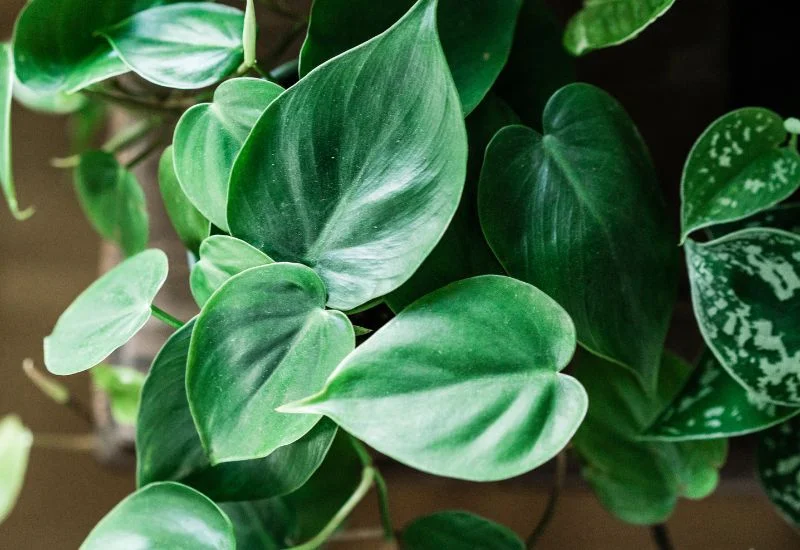In this blog post, you’re going to learn how to easily propagate and care for Philodendron cordatum.
This is a comprehensive guide covering reliable information about different aspects of this cultivated variety.
In this post, I’ll cover:
- Interesting Facts
- Propagation
- Repotting
- Care
And
- Solutions to Common Problems
So, if you are looking to propagate and care for Philodendron cordatum, this guide is for you.
Fun Facts
| Common Name | Philodendron cordatum |
| Botanical Name | Philodendron cordatum |
| Family | Araceae |
| Plant Type | Epiphytic and epilithic species |
| Fruit | Poisonous |
| Mature Size | 100cm tall with 5cm -7cm wide leaves |
| Sun Exposure | Mild sunlight (severe sunlight burn its leaves) |
| Soil Type | A blend of potting soil (perlite or pumice, and orchid bark or coconut coir) |
| Soil pH | 5.5-6.5 |
| Native Area | Southeastern coastal Brazil |
| Toxic | Harmful Calcium Oxalate Crystals |
| Growth | Propagated by Stem Cutting |
Philodendron cordatum is a house plant native to Southeast Brazil. The plant grows best in dim light. Its ability to tolerate varying humidity levels makes it ideal for indoor environments. It has unique properties like consistent leaf shape and size, resilient growth habit, and toxicity to pets and humans.
The growth period of the P. cordatum is influenced by light, temperature, and water. The plant’s active growth season occurs in the hot season from spring to summer. And growth slows significantly on cold days. Under optimal conditions, the plant has a moderate growth rate and produces new leaves.
The leaves of the plant are its most distinctive feature, contributing to its ornamental value. It has heart-shaped leaves that are typically 2-4 inches wide and 4-8 inches long, with a dark green, glossy finish.
Fruit and Flowering
P. cordatum rarely flowers indoors, it can produce flowers under ideal conditions, such as in a greenhouse or in a natural environment. The plant produces a spadix, a type of spike inflorescence. Spadix is surrounded by a spathe, which is a modified leaf that resembles a petal. The spathe is typically greenish-white or pale green. Flowering in it usually occurs in the growth period.
The fruit in it is not commonly seen indoors, but outdoor plants produce small, berry-like fruits. These fruits start green and turn yellow or orange as they mature. Plant is more commonly propagated through stem cuttings due to the ease and speed of this method1.
Summary
P. cordatum is an attractive houseplant that grows in various indoor conditions. It has distinctive heart-shaped leaves. Its ability to tolerate low light and humidity variations makes it a popular choice for plant lovers.
Understanding its growth period, occasional flowering and fruiting habits, and leaf structure can help you keep a plant healthy and vibrant in any indoor garden.
Benefits
With its beauty, glamorous and versatility, the plant also has the following advantages:
Air Filtration
Like other indoor plants, P. cordatum is known for its air-purifying qualities. It helps remove toxins such as formaldehyde from the air, improves indoor air quality, and promotes a healthier living environment.
Low Maintenance
This low-maintenance plant is ideal for both beginner and experienced gardeners. It grows in a variety of lighting conditions, from low to bright indirect light, and can tolerate a wide range of environmental changes.
Stress Reduction
From scientific research, it is proven that indoor plants can reduce stress and improve mood. With its calming green leaves, can contribute to a more relaxing and pleasant indoor atmosphere.
Uses
P.Cordatum has most of its space in ornamental works but a little bit in the educational and medical fields:
Interior Decoration
It is used in interior decoration due to its attractive leaves and easy adaptability. It can be placed on shelves, desks, or window sills, or hung to add greenery to vertical spaces.
Office Spaces
In offices, this plant can improve aesthetics and develop a more creative workspace. Its air-purifying qualities also help to maintain a healthier work environment by boosting productivity.
Living Walls
The climbing nature of this plant makes it an excellent choice for living walls. It can cover large areas with greenery, making it perfect for creating wonderful green walls2.
Gift Plant
Its low maintenance and attractive appearance makes it a courteous gift for plant lovers. It symbolizes love and friendship, a meaningful present for various occasions.
Educational Purposes
This plant can be used in educational settings to teach students about botany, plant care, and the benefits of indoor plants3.
Propagation

Propagating the P. cordatum is a simple and pleasing process. There are a few methods to propagate this, but the most common and successful is stem cuttings.
Stem Cutting Propagation
- Select a Healthy Stem
Choose a healthy stem with at least two or three leaves. It’s best to select a stem that has a node (a small bump where leaves or aerial roots grow).
- Cut the Stem
Using a clean and sharp knife, cut the stem just below a node. Ensure that the cutting is at least 4-6 inches long.
- Prepare the Cutting
Remove the leaves from the lower half of the cutting. This helps to focus the plant’s energy on root development.
- Rooting of the Cutting
Place the cutting in water or directly into a well-draining potting mix.
In Water: Place the cutting in a water pot, ensuring the node is submerged. Change the water every few days to prevent spillage and bacterial growth.
In Soil: Insert the cutting into a pot filled with a standard potting mix. Keep the soil moist but not waterlogged. Place the pot in a warm, bright spot with indirect light.
- Transplanting
Once the roots are about 1-2 inches long (if propagated in water), transplant the cutting into a pot with well-draining soil. If propagated in soil, wait until the cutting shows new growth, and treat the plant as a mature plant.
Repotting
Repotting is necessary after every 1-2 years or when the plant becomes root-bound. If roots are growing out of the drainage holes or the soil is drying out too quickly, then it’s time for repotting.
Steps for Repotting
- Choose the Right Time
The best time to repot is during the spring or early summer when the plant is in its active growing phase.
- Prepare the New Pot
Select a pot that is 1-2 inches larger in diameter than the current pot. Ensure the new pot has drainage holes to prevent waterlogging.
- Prepare the Plant
Water the plant a day before repotting to reduce stress and make it easier to remove from its current pot.
- Remove the Plant from the Pot
Gently tap the sides of the pot to loosen the soil. Carefully turn the pot upside down while supporting the plant with your hand and gently slide it out. If the plant is root-bound, you may need to cut the roots with the inner walls of the pot.
- Prune the Roots
Cut the unnecessary, damaged, or dead roots. This encourages healthy growth and prevents root decay.
- Repotting
Place fresh potting mix at the bottom of the new pot. Position the plant in the center and fill the potting mix around the roots. Press the soil gently to remove air pockets.
- Water and Care
Water the plant thoroughly after repotting to settle the soil. Place the plant in the bright, indirect light. Continue regular care, including watering and feeding with a balanced, water-soluble fertilizer.
By following care tips, you can easily propagate and repot your plant, ensuring it remains healthy, vibrant and continues to build in your indoor space.
Care
Pruning
Pruning is essential to maintain the shape and health of your P. cordatum. Regular pruning encourages growth and removes dead or yellowing leaves.
- Tools: Use clean, sharp scissors or pruning shears to prevent infection.
- Process: Cut just above a leaf node to encourage new growth.
- Timing: Prune during the spring or summer when the plant is actively growing.
Soil
It grows in well-draining soil that retains some moisture but doesn’t become waterlogged.
- Soil Mix: A mix of peat moss, perlite, and regular potting soil works well. You can also use a cactus or succulent mix with added organic matter.
- pH Level: The ideal soil pH is slightly acidic to neutral, ranging from 5.5 to 6.5.
Pot
Choosing the right pot is important for the plant’s health.
- Material: Terracotta or ceramic pots are ideal as they allow better airflow and moisture control. Plastic pots are also suitable, but ensure they have proper drainage holes.
- Size: Select a pot that is 1-2 inches larger in diameter than the current pot when repotting. Ensure the pot is deep enough to accommodate the root system.
Water
Watering needs for it is moderate, and overwatering can lead to spoilage of roots.
- Frequency: Water when the top inch seems dry. Plants usually need watering once a week, but it can vary depending on the environment.
- Method: Water thoroughly until water drains out of the bottom of the pot.
Light
P. cordatum prefers bright, indirect light but can tolerate low light conditions.
- Optimal Light: Place the plant in a spot where it receives filtered sunlight, such as near a north or east-facing window.
- Low Light: While it can survive in low light, growth may slow.
Fertilizer
Regular feeding helps maintain green leaves and promotes healthy growth.
- Type: Use a balanced, water-soluble fertilizer with an NPK (Nitrogen, Phosphorus, and Potassium) in an equal ratio.
- Frequency: Fertilize every 4-6 weeks during the growing season (spring and summer). Reduce feeding in the fall and winter when the plant’s growth is slow.
Placement
Proper placement ensures optimal growth and health of your plant.
- Indoors: Place the plant in a room with bright, indirect light, away from direct sunlight to prevent leaf burn. Bathrooms, kitchens, or living rooms with filtered light are ideal.
- Avoid Drafts: Keep the plant away from cold drafts (cold air moving through in a way that is unpleasant or uncomfortable), heating vents, and air conditioners to prevent stress.
- Humidity: While it tolerates average indoor humidity, higher humidity levels (around 60%) will promote more vigorous growth. You can increase humidity by placing a tray of water near the plant or using a humidifier.
Common Problems
Here are the common problems that can be frustrating to the philodendron lovers;
Pests
This plant is sensitive to common pests, such as;
- Spider Mites: Tiny spider insects that can cause yellowing and stinging on leaves.
- Aphids: Soft-bodied insects that suck sap from the plant, causing retarded growth.
- Scale Insects: Small, hard-shelled insects that attach to stems and leaves, sucking sap and causing yellow spots on plants.
Treatment: Regularly inspect your plant for pests. If you find any, treat the plant with insecticidal soap or neem oil.
Fungal Diseases
Fungal diseases can affect P. cordatum, particularly if the plant is watered too much or the humidity is high. Common fungal issues include:
- Root Rot: Caused by overwatering, leading to watery soil and decayed roots.
- Leaf Spot: Dark, water-soaked spots on leaves caused by fungal spores.
Treatment: To prevent fungal diseases, avoid overwatering, and ensure the plant has good drainage. If root rot is suspected, remove the affected roots and repot the plant in fresh soil.
Brown Tips
Brown tips on the leaves can be due to the following factors:
- Low Humidity: Low humidity and dry air can cause leaf tips to brown.
- Over-fertilization: Excess of fertilizer can lead to leaf burn.
- Underwatering: Insufficient water can cause leaf tips to dry out and turn brown.
Treatment: Increase humidity around the plant by placing a humidifier nearby. Ensure you are watering the plant appropriately and not over-fertilizing.
Curling Leaves
Curling leaves may be a sign of:
- Underwatering: Dry soil can cause leaves to curl as the plant conserves moisture.
- Pests: Insect stimulation can cause leaves to curl as the plant reacts to the stress.
- Temperature Stress: Extreme temperatures, either too hot or too cold, can cause leaves to curl.
Treatment: Check the soil’s moisture and water the plant to see if it is dry. Inspect the plant for pests and treat it accordingly. Ensure the plant is in a location with stable temperatures away from drafts or direct heat sources.
Yellow Leaves
Yellow leaves can be caused by:
- Overwatering: Consistently wet soil can lead to root rot and yellowing leaves.
- Underwatering: Dry soil can also cause leaves to turn yellow and drop.
- Nutrient Deficiency: Lack of essential nutrients, particularly nitrogen, can cause yellowing leaves.
Treatment: Adjust your watering schedule to ensure suitable plant irrigation. Ensure appropriate fertilizing during the growing season. If yellowing persists, consider repotting the plant in fresh soil.
Varieties & Similar Plants
In this section, we are r going to explore the varieties as well as similar plants to Philodendron cordatum;
Varieties of P. Cordatum

This variety features striking variegation with bright green leaves splashed with yellow and lime green patterns.
Care: Similar to the standard plant, it thrives in moderate light and prefers slightly moist soil.
- Philodendron Cordatum ‘Lemon Lime’

Known for its vibrant pea-green or lemon-yellow leaves, this variety adds a pop of color to any indoor garden.
Care: Prefers bright, indirect light and well-draining soil. Regular watering is essential but avoid waterlogging.
Similar Plants within the Philodendron Genus
- Philodendron Hederaceum

Often confused with Philodendron cordatum, Philodendron hederaceum has similar heart-shaped leaves but can exhibit a wider range of leaf sizes and shapes.
Care: Grow in bright, indirect light but can tolerate low light conditions.
- Philodendron Scandens
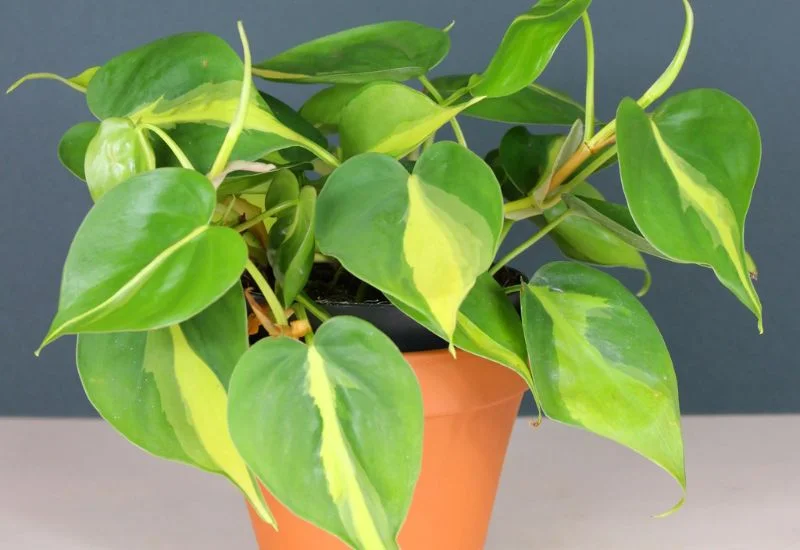
The sweetheart plant is very similar to P. with its trailing vines and heart-shaped leaves.
Care: Low maintenance, adaptable to various light conditions, and prefers well-draining soil.
Similar Plants other than Philodendron Genus
Epipremnum Aureum (Pothos)
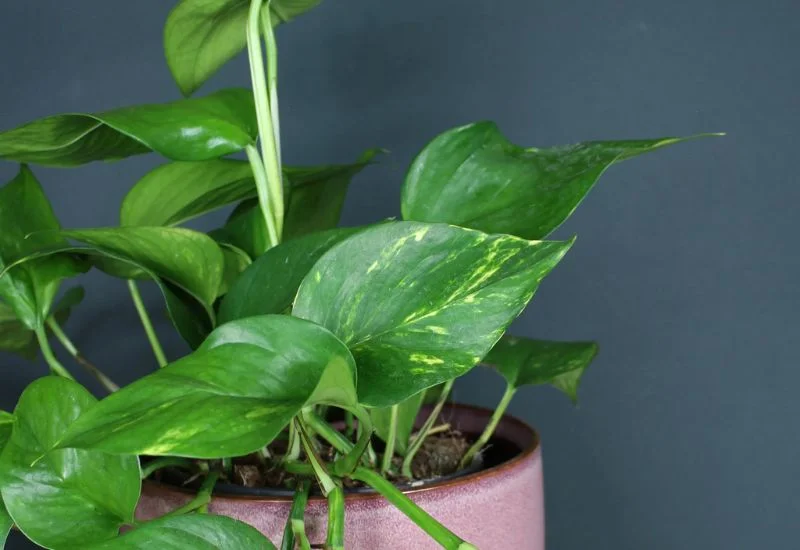
Pothos or devil’s ivy, this plant has heart-shaped leaves that can be green or variegated with white, yellow, or light green.
Care: Very easy to care for, tolerates low light, and can grow in both dry and humid conditions.
Monstera Deliciosa
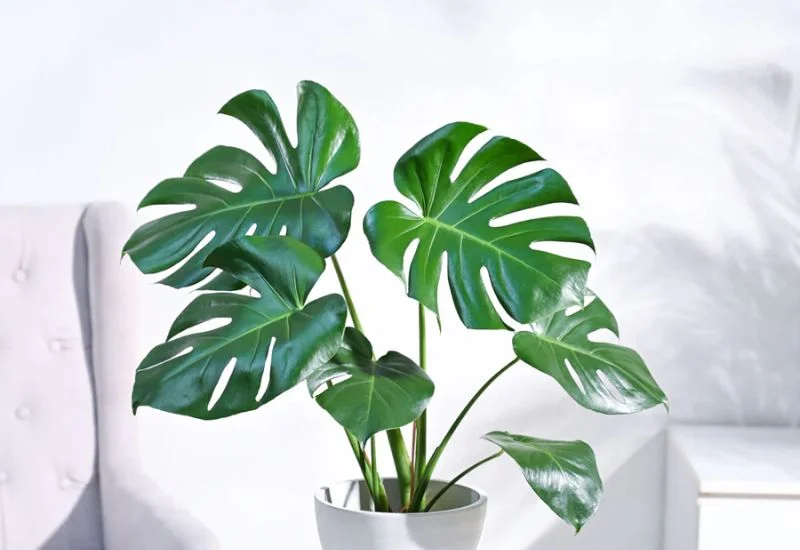
Monstera deliciosa (Swiss cheese plant) has large, perforated leaves that are heart-shaped when young.
Care: Prefers bright, indirect light and high humidity. Needs well-draining soil and regular watering, allowing the soil to dry out between waterings.
Syngonium Podophyllum (Arrowhead Plant)
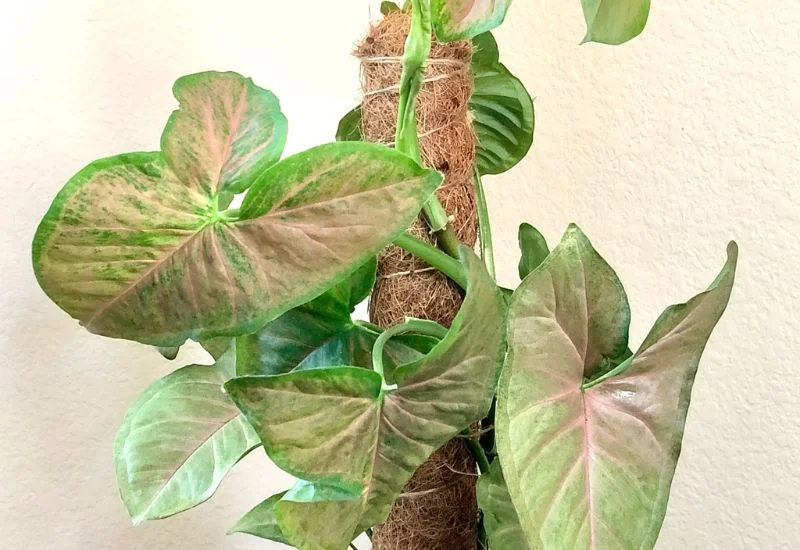
Arrowhead plants have arrowhead-shaped leaves that often start as heart-shaped when young and become more lobed as they mature. The leaves can be green or variegated with white, cream, or pink.
Care: Grows in bright, indirect light but can tolerate low light conditions. Prefers well-draining soil and regular watering.
Ready to Grab a Philodendron cordatum to add beauty to your home garden?
All the above information is reliable, and you’ll see outstanding results if you want to grow or care for this plant.
Frequently Asked Questions
Article Sources
Aquariusmediaa provides reliable information with good-quality references to support the facts.
- Evolution of Philodendron (Araceae) species along Neotropical biomes – PeerJ
↩︎ - Responses to Viewing an Indoor Vertical Greenery System: A Case Study – MDPI ↩︎
- Bioelectrical Potentials of Philodendron Cordatum: A New Method for Investigation – Sage Journals
wonderful green walls. ↩︎
